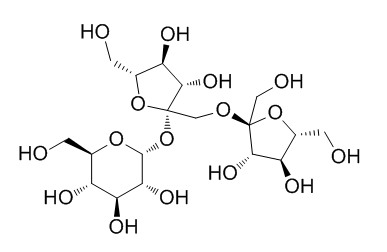1-Kestose
1-Kestose shows significant anti-hydroxyl radical potential. 1-Kestose can promote intestinal Lactobacillus number, and influence the microorganisms as well as the intestinal and systemic immune responses.
Inquire / Order:
manager@chemfaces.com
Technical Inquiries:
service@chemfaces.com
Tel:
+86-27-84237783
Fax:
+86-27-84254680
Address:
1 Building, No. 83, CheCheng Rd., Wuhan Economic and Technological Development Zone, Wuhan, Hubei 430056, PRC
Providing storage is as stated on the product vial and the vial is kept tightly sealed, the product can be stored for up to
24 months(2-8C).
Wherever possible, you should prepare and use solutions on the same day. However, if you need to make up stock solutions in advance, we recommend that you store the solution as aliquots in tightly sealed vials at -20C. Generally, these will be useable for up to two weeks. Before use, and prior to opening the vial we recommend that you allow your product to equilibrate to room temperature for at least 1 hour.
Need more advice on solubility, usage and handling? Please email to: service@chemfaces.com
The packaging of the product may have turned upside down during transportation, resulting in the natural compounds adhering to the neck or cap of the vial. take the vial out of its packaging and gently shake to let the compounds fall to the bottom of the vial. for liquid products, centrifuge at 200-500 RPM to gather the liquid at the bottom of the vial. try to avoid loss or contamination during handling.
Environ Toxicol.2019, 34(12):1354-1362
J Microbiol Biotechnol.2022, 32(2):141-148.
Applied Biological Chemistry2023, 66:85.
Plants (Basel).2023, 12(6):1259.
Int J Oncol.2016, 49(4):1497-504
Food Funct.2021, 12(13):5892-5902.
J Med Food.2020, 23(6):633-640.
Korean Journal of Pharmacognosy2018, 49(1):76-83
Int J Med Sci.2020, 17(5):626-631
Natural Product Sciences2024, 30(1):8-13.
Related and Featured Products
Applied Microbiology & Biotechnology, 1991, 35(2):216-221.
Production of 1-kestose with intact mycelium of Aspergillus phoenicis containing sucrose-1 F -fructosyltransferase[Reference:
WebLink]
METHODS AND RESULTS:
Favourable reaction conditions for the enzymatic production of 1-Kestose by sucrose-1F-fructosyltransferase, SFT (EC 2.4.1.99) from Aspergillus phoenicis CBS 294.80 mycelium were established. The intracellular enzyme SFT works best at 60C, exhibits a relatively high thermostability and possesses an alkaline pH optimum. An invertase also present in the mycelium of A. phoenicis possesses an acidic pH optimum.
CONCLUSIONS:
Consequently, around pH 8.0 sucrose is converted mainly to 1-Kestose and nystose while fructose is only formed in relatively small amounts. Under optimal conditions (55 C, pH 8.0 and an initial sucrose concentration of 750 g 1-1) a yield of about 300 g 1-Kestose per 1.01 reaction mixture could be achieved after 8 h.
International Journal of Food Science & Technology, 2014, 49(6):1500-1505.
In vitro anti‐hydroxyl radical activity of the fructooligosaccharides 1‐kestose and nystose using spectroscopic and computational approaches[Reference:
WebLink]
Fructooligosaccharides (FOS) are bioactive oligosaccharide fructans with beneficial health effects. Anti‐hydroxyl radical activity is an important factor in the description of antioxidant capacity of any natural product. The aim of this study was to estimate in vitro anti‐hydroxyl radical activity of the FOS 1-Kestose and nystose by electron paramagnetic resonance spectroscopy (EPR) and fluorescence spectroscopy (FS) followed by a theoretical approach based on quantum chemistry calculations.
METHODS AND RESULTS:
A significant anti‐hydroxyl radical potential of both compounds was observed (72% and 78% by EPR and 69% and 74% by FS, respectively), indicating the nystose to be a more active natural product. In addition, the computational results have confirmed that nystose follows the same pattern previously shown for 1-Kestose, that is, that carbohydrates can react with hydroxyl radical.
CONCLUSIONS:
It is well known that FOS belong to cardioprotective nutraceuticals, so the study may be of some interest to research in heart disease.
Journal of Applied Glycoscience, 2006, 53(3):175-180.
Effects of 1-kestose and nystose on the intestinal microorganisms and immune system in mice. [Reference:
WebLink]
We investigated the effects of the major short chain fructooligosaccharides, 1-Kestose and nystose, on the intestinal microorganisms and on the intestinal and systemic immune responses of mice.
METHODS AND RESULTS:
Both 1-Kestose and nystose promoted intestinal Lactobacillus number. However, the balance of Lb. reuteri and Lb. intestinalis, the major Lactobacillus species in the mice was not altered. The IgA content in the feces of mice treated with both 1-Kestose and nystose increased from day 4 to day 7 after starting the administration and returned to the same level of control mice on day 14. Splenocyte responses to Con A, anti-CD3 plus anti-CD28 antibodies and LPS were reduced by 1-Kestose and nystose. Nystose lowered IL-2, IFN-γ, IL-12 and IL-4 secretion from the splenocytes more than 1-Kestose.
CONCLUSIONS:
These results suggested that both 1-Kestose and nystose can influence the microorganisms as well as the intestinal and systemic immune responses, but to different degrees.



